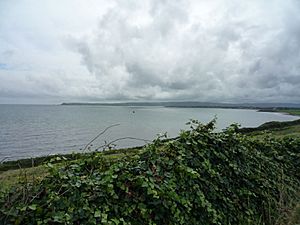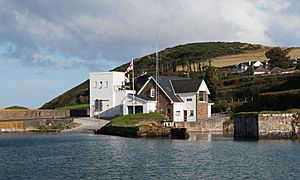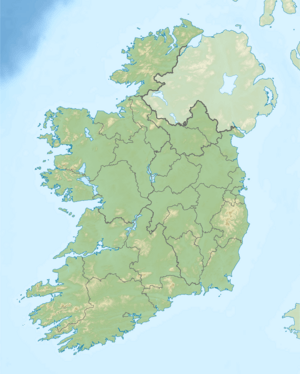Helvick facts for kids
Quick facts for kids Helvick |
|
|---|---|

View from Ballyvoile out to Helvick Head
|
|
| Coordinates | 52°03′13″N 7°32′12″W / 52.053615°N 7.536734°W |
| Geology | Old Red Sandstone |
| Age | 380 million years |
Helvick or Helvick Head (Irish: Heilbhic, Ceann Heilbhic) is a cool piece of land that sticks out into the sea in Ireland. It's located at the southern end of Dungarvan Harbour. This headland is the eastern tip of the Ring Peninsula.
Helvick Head is made from a type of rock called Old Red Sandstone. This rock is super old, about 380 million years! It is the very end of a long rocky ridge that starts all the way near Cork City.
Contents
Discovering Helvick Head
What is a Headland?
A headland is a special type of landform. It is a piece of land that reaches out into the water. Think of it like a nose on a face, but for the land! Helvick Head is an example of this.

Where Did the Name Come From?
The name Helvick is very old. It comes from the Old Norse language. This was the language spoken by the Viking sailors. They explored these coasts a long, long time ago.
The second part of the name, -vík, means "bay." The first part of the name is a bit of a mystery. It might mean "healthy," "white," "holy," or "safe." There's even a place in Norway called Hellvik that has a similar name!
Amazing Wildlife at Helvick
Helvick Head is a very important place for nature. It is a Special Area of Conservation (SAC). This means it is protected to help keep its plants and animals safe.
The tall cliffs at Helvick are perfect nesting spots for many seabirds. You can see birds like choughs and shags here. Other birds that live or visit include razorbills, Northern fulmars, and speedy peregrine falcons. You might also spot black-legged kittiwakes, black guillemots, and common murres (also called guillemots).
Many interesting plants grow around Helvick Head too. Look for bright yellow gorse and purple bell heather. You can also find ling, devil's-bit scabious, and heath bedstraw. Smaller plants like bog violet and burnet rose also thrive here. Near the sea, you might see thrift, kidney vetch, sea mayweed, and wild carrot.


